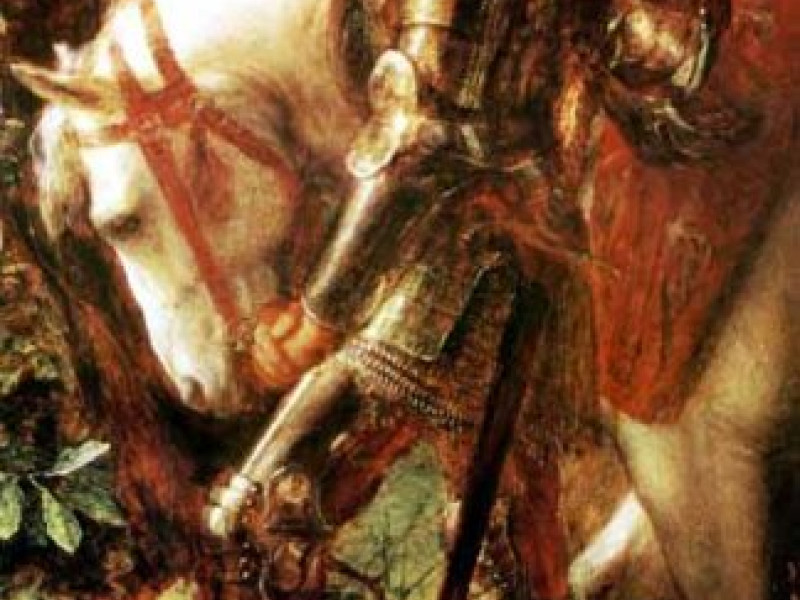Joseph of Arimathea and the Grail
In the New Testament of the Christian Bible, Joseph was a rich man from Arimathea, a town probably about 30 kilometres north-east of Jerusalem.
There is not much information on Joseph. Joseph was one of the members of the Jewish ruling Council [Mark 15.42]. Members of the council including Jewish priests and teachers interrogated Jesus, when Jesus was arrested. Joseph did not approve of his colleagues' action, but was powerless to do anything to help Jesus. Joseph was secretly a follower of Jesus [Matthew 27.57; Luke 24.50-51; John 19.38], but was afraid of the Jewish authorities.
At the Crucifixion on the hill called Golgotha (The Place of the Skull), Pontius Pilate, the Roman governor of Judaea, granted Joseph's request to entomb Christ's body in a nearby, newly carved tomb in a cave [Matthew 27.57-60; Mark 15.42-47; Luke 23.50-56; John 19.38-42]. With the help of Nicodemus, Joseph anointed Jesus' body with spices (myrrh and aloe) before wrapping it in a linen sheet around the body. Then, they closed off the tomb with a large stone. This tomb is now called the Holy Sepulchre, and is the most holy site for the Christians. They built a large church to enclose the places of the Crucifixion and the tomb.
Only the gospel of John mentioned Nicodemus assisting Joseph with the preparation of Jesus' body; in fact, he appeared earlier in this gospel, twice. Nicodemus was a Jewish leader among the Pharisees. Nicodemus had gone to speak with Jesus about the resurrection. Later, when the Pharisees were outraged over Jesus' preaching, Nicodemus tried to calm them down, saying that they couldn't condemn a man without a hearing. In the Arthurian legend, particularly that of the Perlesvaus, the Grail hero Perceval was a direct descendant of Nicodemus, while on his mother's side, he was descended from Joseph's sister.
Not being an enthusiastic Bible reader, I could not find any more reference to Joseph of Arimathea in the New Testament. There was no mention of his family, and he didn't appear again in the Bible after placing Jesus' body in the tomb.
There are several legends and apocryphal writings in which Joseph appeared that Boron may have used to create his own work, but I haven't read these.
In the Bible, there are no connections between Joseph of Arimathea and the cup of the Last Supper (Grail), not even in the apocryphal texts. Joseph had attended the crucifixion, but he did not catch Jesus' blood in the cup, when his side was pierced by Roman spear. This event was invented by Robert de Boron who wrote Joseph d'Arimathie (c. 1200).
His feast was held on two different days: in the East it was held on July 31st, while in West it was held on March 17. To the Arthurian authors, Joseph of Arimathea was the patron saint of Glastonbury (in Somerset, England), which was said to be the location of the Isle of Avalon.
Most of what we know of Joseph of Arimathea comes from Arthurian legends, particularly from a work by a French poet named Robert de Boron (Borron) called Joseph d'Arimathie (c. 1200). Also from the Vulgate Cycle, from a prose adaption called Estoire de Saint Graal, and Queste del Saint Graal (c. 1230).
Joseph and his son-in-law Bron (in Boron's version) or his son Josephus (Vulgate), were keepers of the Grail. Joseph received the Grail when he was thrown in prison, because the Jewish authorities thought he had stolen the body of Jesus after the Crucifixion. Forty-two years after the death and resurrection of Jesus, Joseph was released from prison by the emperor Vespasian. Joseph and his son (Josephus) or his son-in-law (Bron) took the Grail to Britain, where it was kept until the time of King Arthur.
Obviously, Boron's source for the imprisonment of Joseph came from the apocryphal Gospel of Nicodemus, since there was no more information about Joseph after placing Jesus' body in the tomb. Except that Joseph was immediately put in prison by the Jews for putting Jesus' body in the tomb.
Joseph also had another son who was named Galahad, king of the Hosselice. (Hosselice was another name for Wales). Lancelot and the Grail hero Galahad later found his tomb. These heroes were therefore descendants of Joseph of Arimathea.
Joseph of Arimathea and his son (Josephus) befriended the pagan king of Sarras named Evalach (Mordrain), and his brother-in-law and seneschal named Seraph (Nascien). Josephus became a bishop at Sarras, and aided Mordrain.
When Joseph and son went to Britain, they were imprisoned by the pagan king but were rescued by Mordrain. Joseph was wounded in the thigh by a broken sword. (Later in the quest, Galahad would restore the Broken Sword and give it to Bors. See Holy Grail in the Quest of the Holy Grail.)
(Most of my information about Joseph of Arimathea in the Arthurian legend comes from the Queste del Saint Graal (Vulgate Cycle), because I could not find an affordable English translation of Joseph d'Arimathie (by Robert de Boron).
The Arthurian writers not only considered Joseph to be a saint, but also that he and his son were one of the earliest and greatest Christian knights.
Related Information
Name
Joseph d'Arimathea.
Sources
Joseph of Arimathea, Merlin and Perceval were written by Robert de Boron (c. 1200).
The Didot Perceval (1210).
Queste del Saint Graal come from Vulgate Cycle, c. 1230.
Estoire de Saint Graal (History of the Holy Grail) come from Vulgate Cycle, c. 1240.
"Suite du Merlin" or "Merlin Continuation" (Post-Vulgate, c. 1250).
Holy Bible (King James' version).
Good News Bible.
Related Articles
Bron, Galahad, Mordrain, Nascien.
Holy Grail, Origin of the Grail.
Genealogy: House of the Grail Kings.
By Jimmy Joe






